Medicaid Asset Limits in Oklahoma (2025)
To qualify for long-term care Medicaid in Oklahoma, applicants must meet specific asset limits, which vary based on marital status and application circumstances.
For Single Applicants:
-
Asset Limit: $2,000 in countable assets.
For Married Couples:
-
Both Spouses Applying: Combined asset limit of $3,000.
-
One Spouse Applying (Community Spouse Resource Allowance - CSRA):
-
The non-applicant (community) spouse can retain half of the couple’s total assets up to $157,920.
-
The applicant spouse must reduce their portion of countable assets to $2,000.
-
📋 What is a Countable Asset?
Countable assets include:
-
Cash, checking, and savings accounts
-
Certificates of deposit (CDs)
-
The cash value of life insurance exceeding $1,500
-
Stocks, bonds, and mutual funds
-
Retirement accounts (e.g., IRAs, 401(k)s)
-
Real estate other than the primary residence
-
Additional vehicles beyond the first
🏠 Exempt (Non-Countable) Assets
Certain assets are exempt and do not count toward Medicaid's asset limits:
-
Primary Residence: Exempt if the applicant intends to return home or if a spouse or dependent resides there. Note: There may be a home equity limit (e.g., $730,000) for exemption. Caution: A primary residence can lose its exemption and become subject to “estate recovery”
-
One vehicle, regardless of value
-
Personal belongings and household items
-
Irrevocable burial trusts up to $7,500
-
Life insurance policies with a cash value of $1,500 or less
⏳ The 5-Year Look-Back Period
Federal law requires states to enforce a 60-month (5-year) look-back period for asset transfers. If an applicant has transferred assets for less than fair market value during this period, it will result in a penalty period – a calculated time of Medicaid ineligibility during which the applicant must pay for care from other sources.
This rule aims to prevent individuals from giving away assets to qualify for Medicaid. If an asset transfer penalty applies, it is critical to become Medicaid eligible in all other respects, because the transfer penalty cannot begin until other eligibility requirements are fully met.
⚖️ Legal Strategies for Asset Protection
If your assets exceed the allowable limits, or you have engaged in asset transfers during the look-back period, there are still legal strategies available to you:
-
Medicaid-Compliant Annuities: Converting assets into a stream of income for the community spouse.
-
Irrevocable Trusts: Transferring assets into a trust to remove them from countable assets (must be done well in advance due to the look-back period).
-
Qualified Income Trusts (Miller Trusts): For applicants whose income exceeds Medicaid limits, this trust can help qualify for benefits.
-
Structured Transfer Corrections: Planning designed to shorten the penalty period with a structured payment arrangement.
📞 Need Assistance?
Navigating Medicaid's asset requirements can be complex. Consulting with an experienced Medicaid law attorney can help you:
-
Get Medicaid qualified as fast as possible
-
Understand which assets are countable vs. exempt
-
Develop a personalized eligibility plan
-
Protect your home and savings
-
Ensure compliance with Medicaid regulations
Contact us today to schedule a consultation and secure your financial future while ensuring access to necessary long-term care services.
